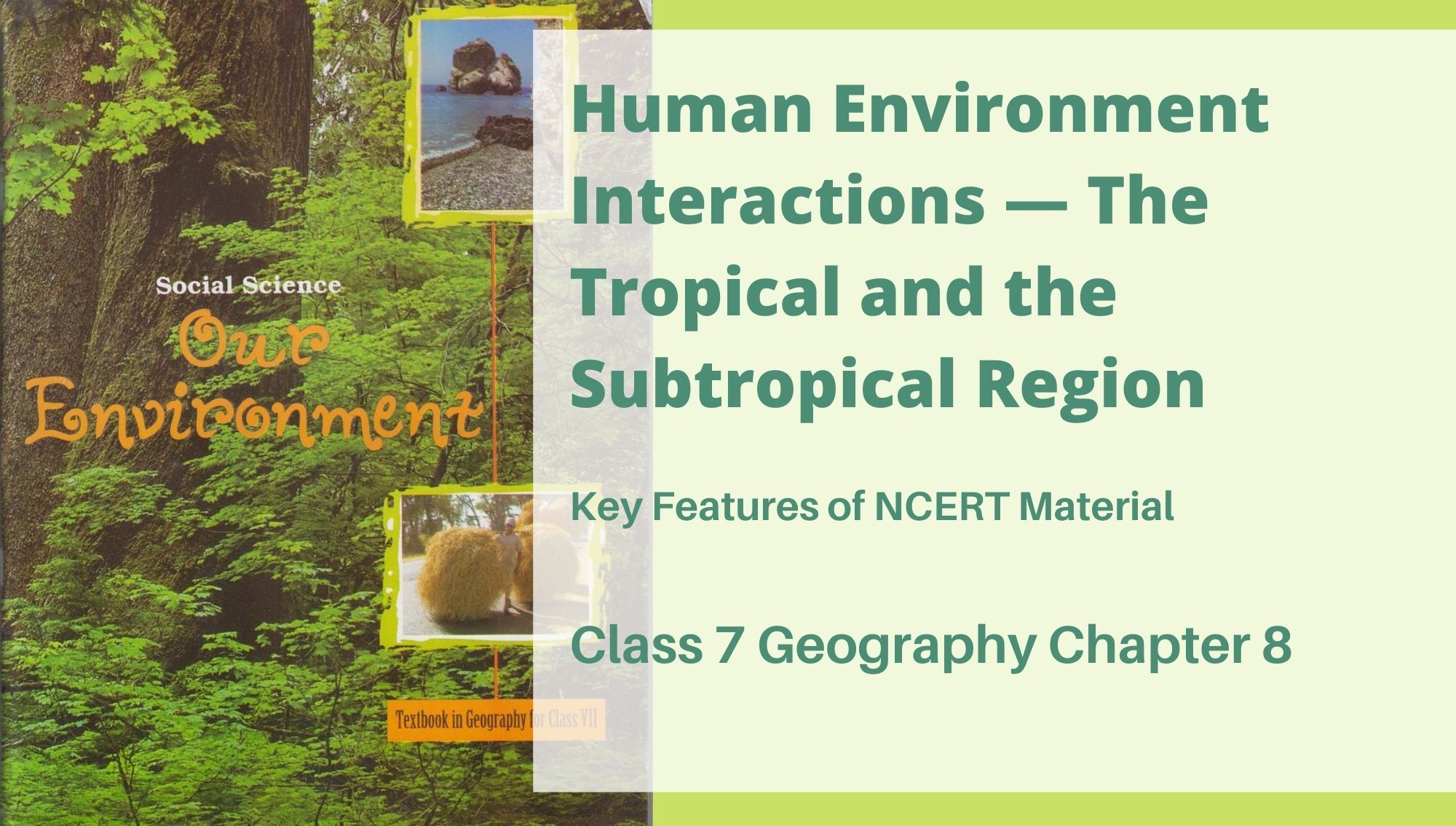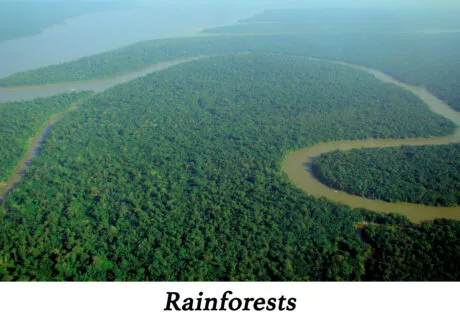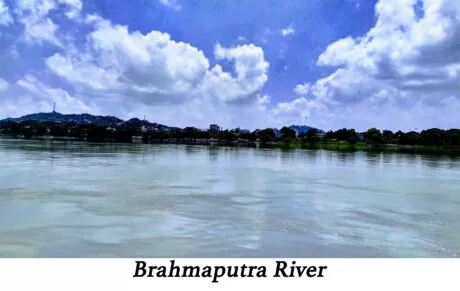Human Environment Interactions — The Tropical and the Subtropical Region Class 7 Geography NCERT Chapter 8

Key Features of NCERT Material for Class 7 Geography Chapter 8 – Human Environment Interactions — The Tropical and the Subtropical Region
In previous chapter 7, we learnt settlements and their types, different means of transports and communication. In this chapter: Human Environment Interactions — The Tropical and the Subtropical Region, we will study about life at Amazon-basin and Ganga-Brahmaputra basin. We will also learn about rainforests and people at rainforests.
Quick revision notes
People interact with the environment and are reliant on it for various things.
Life in the Amazon Basin
- The Amazon River Basin lies close to the equator.
- Amazon river was found by a Spanish explorer, Vicente Yanez Pinzon.
- The Amazon basin lies in the tropical region near the equator somewhere in the range of 10°N and 10°S, and so, the river Amazon moves through this region.
- The Amazon river basin drains parts of Brazil, portions of Peru, Bolivia, Ecuador, Columbia and a little portion of Venezuela.
Climate
- The Amazon basin extends directly on the equator and is characterized by hot and wet atmosphere consistently through the year.
- There are substantial precipitation and high humidity.
Rainforest
- As it rains vigorously, thick forests grow in this region.
- The forest is so thick that the thick rooftop made by leaves and branches doesn’t allow the daylight to arrive at the ground.
- The rainforest has various species of flora and fauna.
- The basin is home to many types of insects.
People of the Rainforests
- Individuals cultivate the vast majority of their food in little areas after clearing a few trees in the forest.
- Slash and burn agriculture is common.
- The increasing activities are slowly leading to the destruction of the biologically diverse rainforest.
Life in the Ganga-Brahmaputra Basin
- Ganga-Brahmaputra basin situated in the Indian subcontinent is formed by the tributaries of rivers Ganga and Brahmaputra.
- The plains of the Ganga and the Brahmaputra, the mountains and foothills of the Himalayas and the Sunderbans delta are the most important highlights of this region.
- The Ganga and Brahmaputra rivers together form the biggest delta on the planet.
- So, the basin territory has a varied topography. The mountain regions with steep inclines have aloof terrain.
 Agriculture is the principle occupation of the individuals where flat land is accessible to develop new yields.
Agriculture is the principle occupation of the individuals where flat land is accessible to develop new yields. - Wheat, maize sorghum, gram and millets are the significant harvests of the area.
- The vegetation cover of the zone changes according to the kind of landforms.
- There is an assortment of wildlife in the basin. Whereas, In the delta zones, Bengal tiger, crocodiles and alligators are found.
- Fish and rice is the staple eating routine of individuals. Different species of fish are found in this region.
- The Ganga-Brahmaputra plain has a few major towns and cities like Kanpur, Allahabad, Varanasi, Kolkata, Patna and Lucknow.
- Each of the four methods of transport is very much evolved in the Ganga-Brahmaputra Basin.
- Tropical deciduous trees develop in the Ganga, Brahmaputra plain. Likewise, one can find Teak, sal and peepal here. Mangrove forests are found on the delta.
- Tourism is a significant activity in the locale. Here, the vacationers from various parts of the world come to see the Taj Mahal, Buddhists stupas, Imambara, wildlife sanctuaries and so forth.
Amazon Basin
The Amazon Basin lies in the equatorial area. The river Amazon passes through this region. Different tributaries from different regions join the Amazon River to form the Amazon Basin.
The Amazon river basin drains parts of Brazil, portions of Peru, Bolivia, Ecuador, Columbia and a little portion of Venezuela.
The atmosphere of the Amazon Basin is hot and wet consistently throughout the year. It almost rains every day. So, during day time temperatures are high yet around evening time the temperature goes down.
Amazon Basin has thick forests. As daylight doesn’t reach the ground, just shade-tolerant vegetation grows here, for instance, orchids and bromeliads.
The rainforest is very rich in fauna. There are a variety of birds found here. Aside from creatures like monkeys, sloth, etc which are present, there are different types of reptiles and snakes are found as well in these forests.
The Basin is likewise the home to many different species of insects.
The individuals of the Amazon Basin are mostly occupied with agriculture. So, they cultivate tapioca, pineapple and sweet potato. Manioc is their staple food. They likewise cultivate cash crops like coffee, maize and cocoa.
The life of the individuals of the Amazon basin is gradually going through a change, in 1970 the Trans-Amazon highway made the complete rainforest accessible. Whereas, the use of aeroplane and helicopters is for arriving at different places.
Because of these developmental exercises, an enormous area of the rainforest has been vanishing yearly in the Amazon Basin.
Mouth:
where a river streams into another river is the river’s mouth.
Tributaries:
These are little rivers that join the primary river.
Bromeliads:
These are extraordinary plants that have the ability to store water in their leaves.
Slash and Burn Agriculture:
It is a sort of cultivation where farmers cut down trees and bushes to clear a piece of land. These are then burnt which discharges the nutrients into the soil. So the field gets ready for growing yields.
Manioc:
This is the staple food of individuals of the Amazon basin.
Maloca:
Large flat like houses with steeply inclining rooftops is malocas.
Populace Density:
It alludes to the quantity of people that live in one sq. km. of the zone.
Terrace Farming:
It is a kind of cultivating where terraces are constructed on steep inclines to create level surfaces on which harvests are grown. The incline is removed with the goal that water doesn’t run off quickly.
Piranha:
It is a sort of fish that eats flesh.



 Agriculture is the principle occupation of the individuals where flat land is accessible to develop new yields.
Agriculture is the principle occupation of the individuals where flat land is accessible to develop new yields.
0 responses on "Human Environment Interactions — The Tropical and the Subtropical Region Class 7 Geography NCERT Chapter 8"